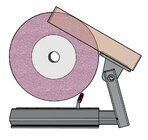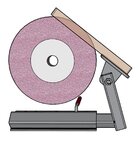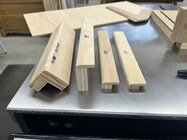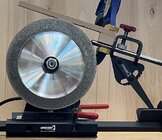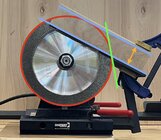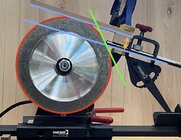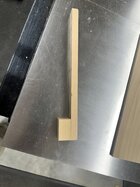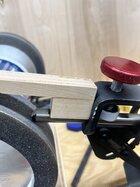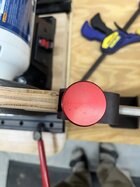Greetings all. Here is a simple way to set an angle for the Oneway Wolverine Grinding Jig with the platform or the Vari-Grind jig.
Consider two (transparent) jointed pieces of wood with the same dimensions except one is wider. Place each on with one edge on the platform and then rotate the platform until the opposite parallel edge is tangent with the grinding wheel. The platform will have a lower angle for the wider piece.
The angle of the bevel ground into a bowl gouge placed on the platform also changes. The wider piece corresponds to a platform angle that produces a larger bevel angle.
There is a relatively simple mathematical relationship between the width of the piece of wood and the bevel angle. If r is the radius of the grinding wheel and A is the bevel angle then the width of the piece of wood is r (1- cos A). So, we can make simple jigs that consist of a jointed piece of wood of various widths to obtain our desired bevel angles for bowl gouges. The jig becomes easier to use if we add a lip to the top edge so that the jig can rest on the wheel and establish the tangency. Still easier for some of us, clamp the jig to the platform so that you can just rotate the platform down until the lip rests on the grinding wheel, tighten the platform clamp, and you have your platform in place.
To be continued ... (I attached a PDF with an explanation of the formula.)
Consider two (transparent) jointed pieces of wood with the same dimensions except one is wider. Place each on with one edge on the platform and then rotate the platform until the opposite parallel edge is tangent with the grinding wheel. The platform will have a lower angle for the wider piece.
The angle of the bevel ground into a bowl gouge placed on the platform also changes. The wider piece corresponds to a platform angle that produces a larger bevel angle.
There is a relatively simple mathematical relationship between the width of the piece of wood and the bevel angle. If r is the radius of the grinding wheel and A is the bevel angle then the width of the piece of wood is r (1- cos A). So, we can make simple jigs that consist of a jointed piece of wood of various widths to obtain our desired bevel angles for bowl gouges. The jig becomes easier to use if we add a lip to the top edge so that the jig can rest on the wheel and establish the tangency. Still easier for some of us, clamp the jig to the platform so that you can just rotate the platform down until the lip rests on the grinding wheel, tighten the platform clamp, and you have your platform in place.
To be continued ... (I attached a PDF with an explanation of the formula.)
Attachments
Last edited:

